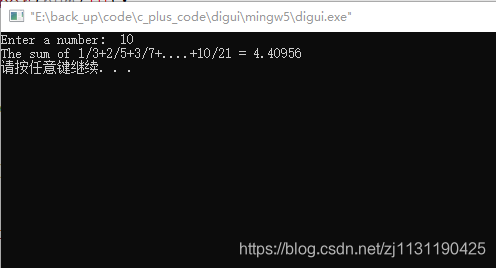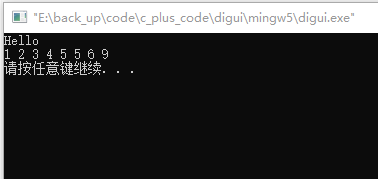C++课后题:
1.采用递归逆序打印一个整数中所有的数字:(简单)
#include <iostream>
#include <string>
using namespace std;
void reverstNumber(int num)
{
if(num>0)
{
cout << (num%10);
reverstNumber(num/10);
}
//cout << endl;
}
int main(int argc, char *argv[])
{
int number;
cout << "Enter a number: ";
cin >> number;
reverstNumber(number);
cout << endl;
return 0; //
}
2. 采用递归的方法实现字符串逆序输出:
#include <iostream>
#include <string>
using namespace std;
void reverstNumber(int num)
{
if(num>0)
{
cout << (num%10);
reverstNumber(num/10);
}
//cout << endl;
}
// 这里考虑写一个recursive helper function
void reverseString(const string& ss)
{
if(ss.size()>0) // 停止条件
{
cout << ss[ss.size()-1]; //输出字符串最后一个字符
reverseString(ss.substr(0, ss.size()-1));
}
}
int main(int argc, char *argv[])
{
string s;
cout << "Enter a string: ";
getline(cin, s);
reverseString(s);
cout << endl;
return 0;
}
运行结果:
3.使用递归实现级数求和m(i)=1/3 + 2/5 + 3/7 + ......+ i/(2i+1)
该问题可以分解为:
m(i)=i/(2i+1)+m(i-1)
停止条件为i>0
代码:
#include <iostream>
#include <string>
using namespace std;
void reverstNumber(int num)
{
if(num>0)
{
cout << (num%10);
reverstNumber(num/10);
}
//cout << endl;
}
// 这里考虑写一个recursive helper function
void reverseString(const string& ss)
{
if(ss.size()>0) // 停止条件
{
cout << ss[ss.size()-1]; //输出字符串最后一个字符
reverseString(ss.substr(0, ss.size()-1));
}
}
double sumCascade(int n) // 求级数的前n项和
{
if(n>0) // 停止条件
return static_cast<double>(n)/static_cast<double>(2*n+1) + sumCascade(n-1);
}
int main(int argc, char *argv[])
{
int number;
cout << "Enter a number: ";
cin >> number;
cout << "The sum of 1/3+2/5+3/7+....+" << number << "/" << (2*number+1) << " = " << sumCascade(number) << endl;
return 0;
}
运行结果:

2018-12-23
-----------------------------------分割线----------------------------------------
又来更新啦
用递归的方式实现选择排序:
代码:
#include <iostream>
#include <string>
using namespace std;
// 递归的方法实现选择排序
template<typename T>
void selectSort(T list[], int n)
{
if(n>1)
{
int max_index = 0;
int max_number = list[0];
for(int i=1; i<n; i++)
{
if(list[i]>=max_number)
{
max_number = list[i];
max_index = i;
}
}
// 找到最大值与最大值的index
list[max_index] = list[n-1];
list[n-1] = max_number;
selectSort(list, n-1);
}
}
int main(int argc, char *argv[])
{
cout << "Hello" << endl;
int a[] = {1,5,2,9,5,6,4,3};
selectSort(a, 8);
for(int i=0; i<8; i++)
{
cout << a[i] << " ";
}
cout << endl;
return 0;
}
运行结果:

用递归的方式写冒泡排序:
一次冒泡的过程,数列的最大元素一定会移动到数列的尾部,这与选择排序中寻找序列最大值并将其放到队尾的操作一致,接着对前n-1个元素进行相同的操作,所以可以用递归的方式实现这一过程。
#include <iostream>
#include <string>
using namespace std;
template<typename T>
void bulbSort(T list[], int n)
{
if(n>1)
{
for(int i=0; i<n-1; i++)
{
if(list[i]>list[i+1])
{
T temp = list[i+1];
list[i+1] = list[i];
list[i] = temp;
}
}
bulbSort(list, n-1);
}
}
int main(int argc, char *argv[])
{
cout << "Hello" << endl;
int a[] = {1,5,2,9,5,6,4,3};
// selectSort(a, 8);
bulbSort(a, 8);
for(int i=0; i<8; i++)
{
cout << a[i] << " ";
}
cout << endl;
return 0;
}
实现插入排序的非递归版本:
#include <iostream>
#include <string>
#include <time.h>
using namespace std;
template<typename T>
void insertionSort(T list[], int n) // 注意选择排序的思路
{
for(int i=1; i<n; i++) // 从a[i](i=1;i<n)开始,向前遍历
{
T temp = list[i]; // a[i]插入a[0: i-1]
int j;
for(j=i-1; j>=0&&temp<list[j]; j--) // 数组元素后移
{
list[j+1] = list[j];
}
list[j+1] = temp; // list[j+1]
}
}
int main(int argc, char *argv[])
{
int a[] = {5, 6, 2, 1, 4, 9, 0};
insertionSort(a, 7);
for(int i=0; i<7; i++)
{
cout << a[i] << " ";
}
cout << endl;
return 0;
}